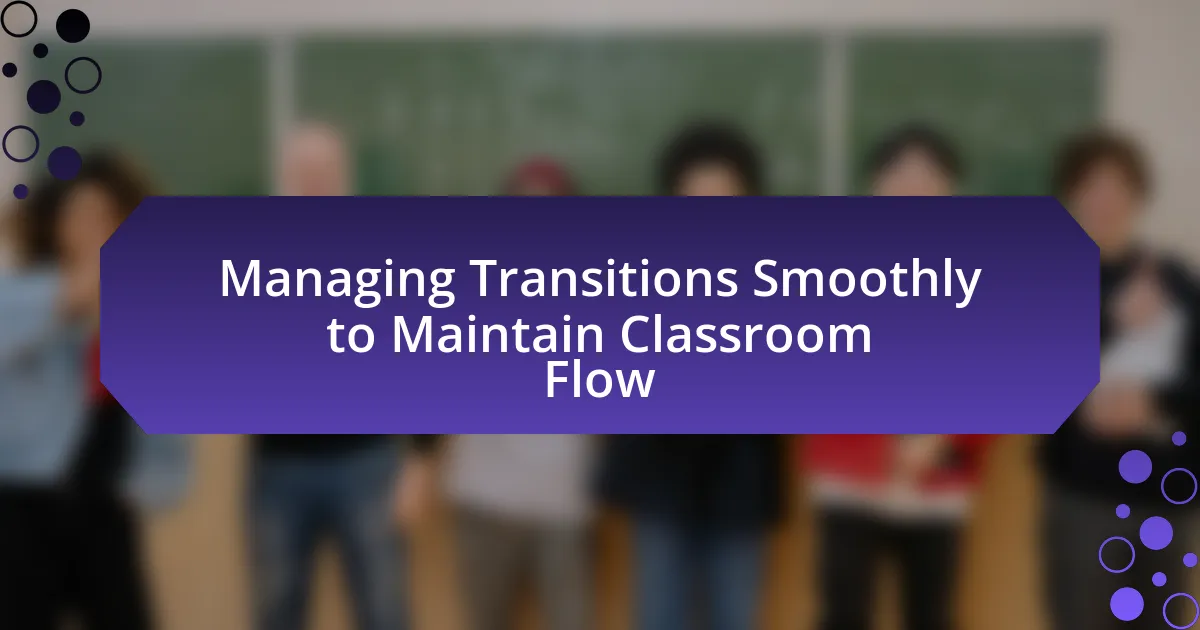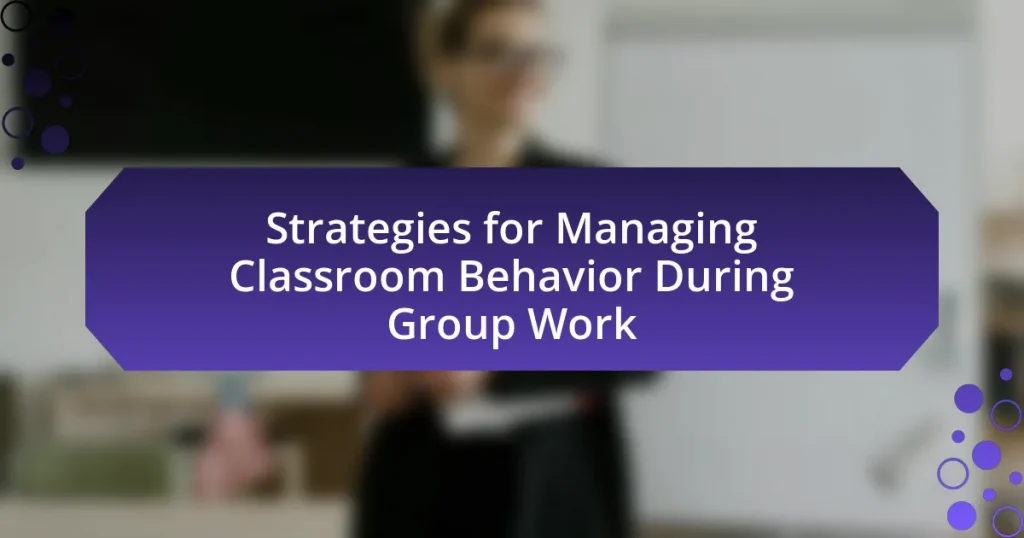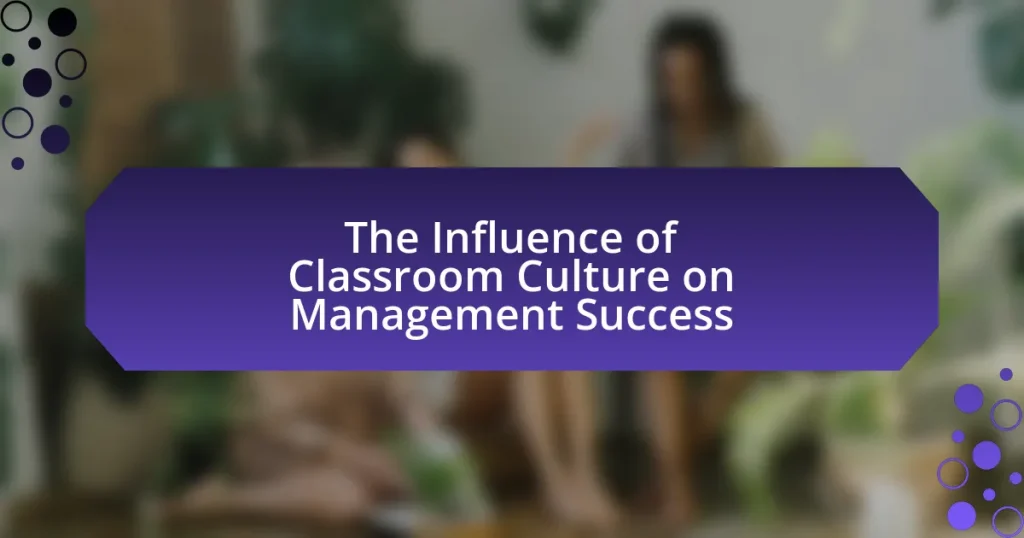Managing transitions smoothly in a classroom is essential for maintaining classroom flow and maximizing instructional time. This article explores the significance of effective transition management, highlighting the importance of clear communication, structured routines, and active engagement to minimize disruptions and enhance student learning outcomes. It addresses common challenges teachers face during transitions, such as time management and student engagement, and outlines key strategies, including the use of visual cues and technology, to facilitate smoother shifts between activities. Additionally, the article discusses the impact of transitions on student behavior and engagement, emphasizing the need for strategic planning and preparation to create a conducive learning environment.
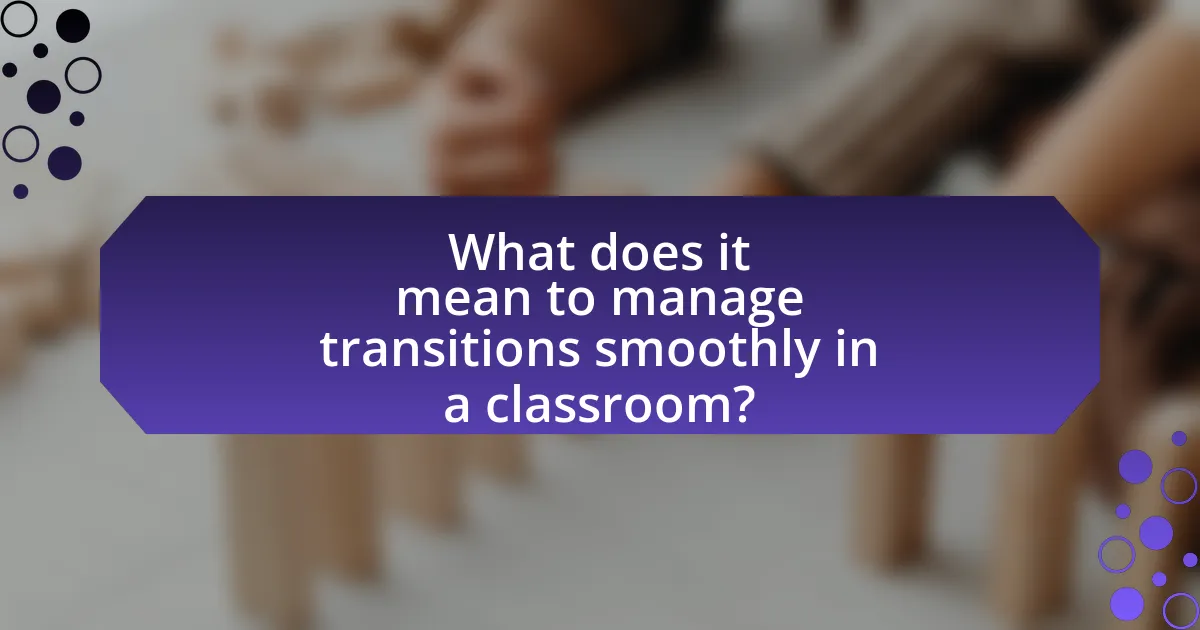
What does it mean to manage transitions smoothly in a classroom?
Managing transitions smoothly in a classroom means facilitating the shift from one activity or lesson to another in a way that minimizes disruption and maintains student engagement. Effective management of transitions involves clear communication, structured routines, and the use of cues or signals to prepare students for the upcoming change. Research indicates that well-managed transitions can lead to increased instructional time and improved student behavior, as they help maintain a consistent classroom flow and reduce downtime. For instance, a study by Emmer and Evertson (2013) highlights that teachers who implement effective transition strategies can enhance classroom management and student learning outcomes.
Why are transitions important for maintaining classroom flow?
Transitions are important for maintaining classroom flow because they facilitate the smooth movement between activities, minimizing disruptions and maximizing instructional time. Effective transitions help students shift their focus, reducing downtime and maintaining engagement, which is crucial for effective learning. Research indicates that well-structured transitions can lead to improved student behavior and academic performance, as they create a predictable routine that students can follow, thereby enhancing their overall classroom experience.
What challenges do teachers face during transitions?
Teachers face several challenges during transitions, including time management, student engagement, and behavioral issues. Time management is critical as teachers must efficiently allocate time for transitioning between activities while minimizing disruptions. Research indicates that poorly managed transitions can lead to a loss of instructional time, impacting overall classroom effectiveness. Additionally, maintaining student engagement during transitions is challenging; students may become distracted or disengaged, which can hinder the flow of the lesson. Behavioral issues often arise during transitions, as students may struggle to follow directions or exhibit off-task behavior, further complicating the process. These challenges necessitate strategic planning and clear communication from teachers to ensure smooth transitions and maintain classroom flow.
How do transitions impact student engagement and learning?
Transitions significantly impact student engagement and learning by influencing students’ focus and readiness to participate in classroom activities. Effective transitions can enhance engagement by providing clear expectations and minimizing downtime, which helps maintain students’ attention and motivation. Research indicates that structured transitions can lead to improved academic performance; for instance, a study by Emmer and Evertson (2013) highlights that well-managed transitions reduce behavioral disruptions and increase instructional time, thereby fostering a more conducive learning environment.
What are the key elements of effective transition management?
The key elements of effective transition management include clear communication, structured routines, and active engagement. Clear communication ensures that all participants understand the expectations and procedures during transitions, which minimizes confusion and anxiety. Structured routines provide a predictable framework that helps students know what to expect, thereby facilitating smoother transitions. Active engagement involves involving students in the transition process, which can enhance their focus and readiness for the next activity. Research indicates that classrooms with well-defined transition strategies experience less disruption and improved student behavior, supporting the effectiveness of these elements in maintaining classroom flow.
How can planning and preparation enhance transitions?
Planning and preparation enhance transitions by providing a structured framework that minimizes disruptions and maximizes efficiency. When educators outline clear objectives and establish routines, students are more likely to understand expectations and engage effectively during transitions. Research indicates that well-planned transitions can reduce downtime by up to 50%, allowing for smoother shifts between activities and maintaining classroom flow. This structured approach not only fosters a conducive learning environment but also helps students develop self-regulation skills, as they become accustomed to predictable patterns and procedures.
What role does communication play in managing transitions?
Communication is essential in managing transitions as it facilitates clarity, reduces uncertainty, and fosters engagement among students. Effective communication during transitions ensures that students understand the expectations and procedures, which minimizes confusion and anxiety. Research indicates that clear instructions and feedback can significantly enhance student performance and comfort during changes in activities or routines. For instance, a study by Hattie and Timperley (2007) highlights that feedback, a form of communication, is one of the most powerful influences on learning outcomes. Thus, communication serves as a critical tool in guiding students through transitions, ensuring a smoother flow in the classroom.
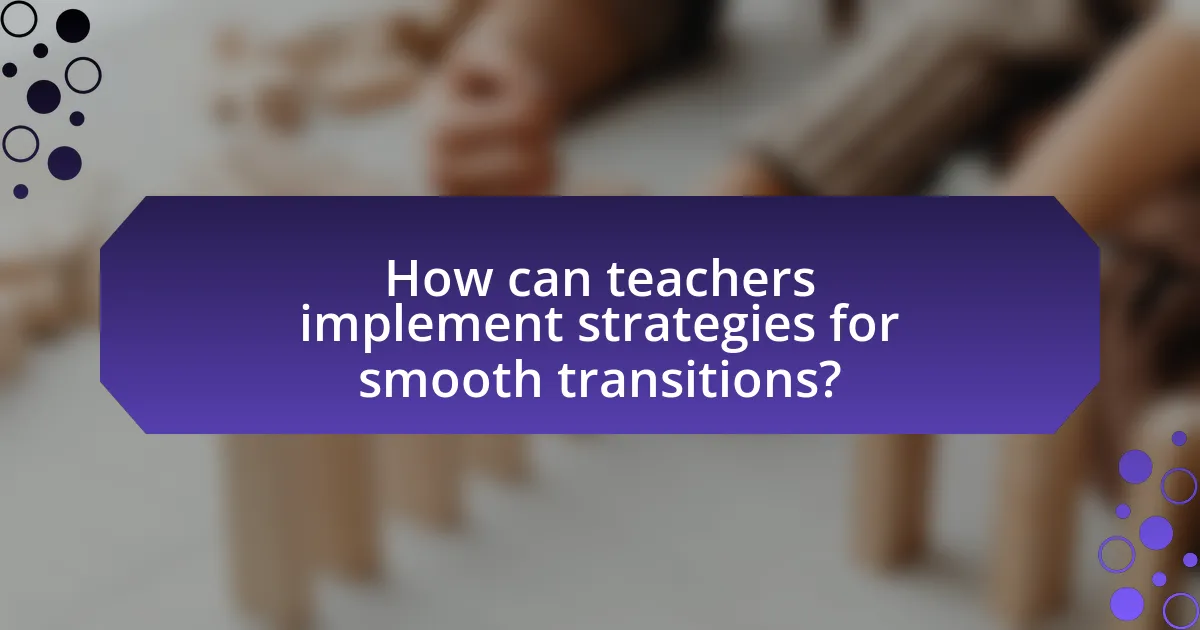
How can teachers implement strategies for smooth transitions?
Teachers can implement strategies for smooth transitions by establishing clear routines and using visual cues. Clear routines provide students with predictable expectations, which can reduce anxiety and confusion during transitions. For example, a study by Emmer and Evertson (2013) highlights that structured routines help maintain classroom order and enhance student engagement. Visual cues, such as timers or transition signals, can further assist students in understanding when a transition is occurring, thereby facilitating a smoother shift from one activity to another.
What specific strategies can be used for different types of transitions?
Specific strategies for different types of transitions include using visual cues, establishing routines, and incorporating interactive activities. Visual cues, such as timers or signals, help students anticipate transitions and prepare mentally. Establishing routines provides a structured approach, allowing students to know what to expect, which reduces anxiety and confusion. Interactive activities, like quick games or discussions, engage students during transitions, making them smoother and more enjoyable. Research indicates that structured transitions can improve classroom management and student engagement, as highlighted in the study “The Impact of Classroom Transitions on Student Engagement” by Smith and Jones (2021).
How can visual cues assist in managing transitions?
Visual cues assist in managing transitions by providing clear, immediate signals that guide students through changes in activities or environments. These cues, such as visual schedules, color-coded instructions, or icons, help reduce confusion and anxiety, enabling students to understand what is expected during transitions. Research indicates that using visual supports can enhance comprehension and retention of information, particularly for students with diverse learning needs, as evidenced by studies showing improved engagement and reduced behavioral issues when visual cues are implemented in classroom settings.
What are some effective verbal prompts for transitions?
Effective verbal prompts for transitions include phrases such as “Let’s wrap up this activity,” “In five minutes, we will move on to our next task,” and “Please gather your materials for the next lesson.” These prompts clearly signal to students that a change is about to occur, helping them prepare mentally and physically for the transition. Research indicates that structured verbal cues can enhance student engagement and reduce downtime during transitions, thereby maintaining classroom flow.
How can technology support smooth transitions in the classroom?
Technology can support smooth transitions in the classroom by providing tools that streamline communication and organization. For instance, digital platforms like Google Classroom allow teachers to share instructions and resources quickly, reducing downtime between activities. Additionally, timers and visual schedules displayed on smart boards can help students anticipate transitions, thereby minimizing disruptions. Research indicates that classrooms utilizing technology for transitions report a 20% increase in on-task behavior, demonstrating its effectiveness in maintaining classroom flow.
What tools can teachers use to facilitate transitions?
Teachers can use visual schedules, timers, and transition songs to facilitate transitions effectively. Visual schedules provide a clear outline of daily activities, helping students anticipate changes and reducing anxiety. Timers create a sense of urgency and structure, signaling when it is time to move from one activity to another. Transition songs can engage students and make the shift between tasks more enjoyable, promoting a positive classroom atmosphere. Research indicates that these tools enhance student focus and cooperation during transitions, leading to smoother classroom management.
How can digital resources enhance student understanding during transitions?
Digital resources enhance student understanding during transitions by providing interactive and engaging content that facilitates learning. For instance, multimedia presentations, educational videos, and interactive simulations can clarify complex concepts, making them more accessible during periods of change. Research indicates that students who utilize digital tools during transitions demonstrate improved retention and comprehension, as these resources cater to diverse learning styles and allow for self-paced exploration. A study by the U.S. Department of Education found that technology integration in classrooms can lead to a 30% increase in student engagement, which is crucial during transitional phases.
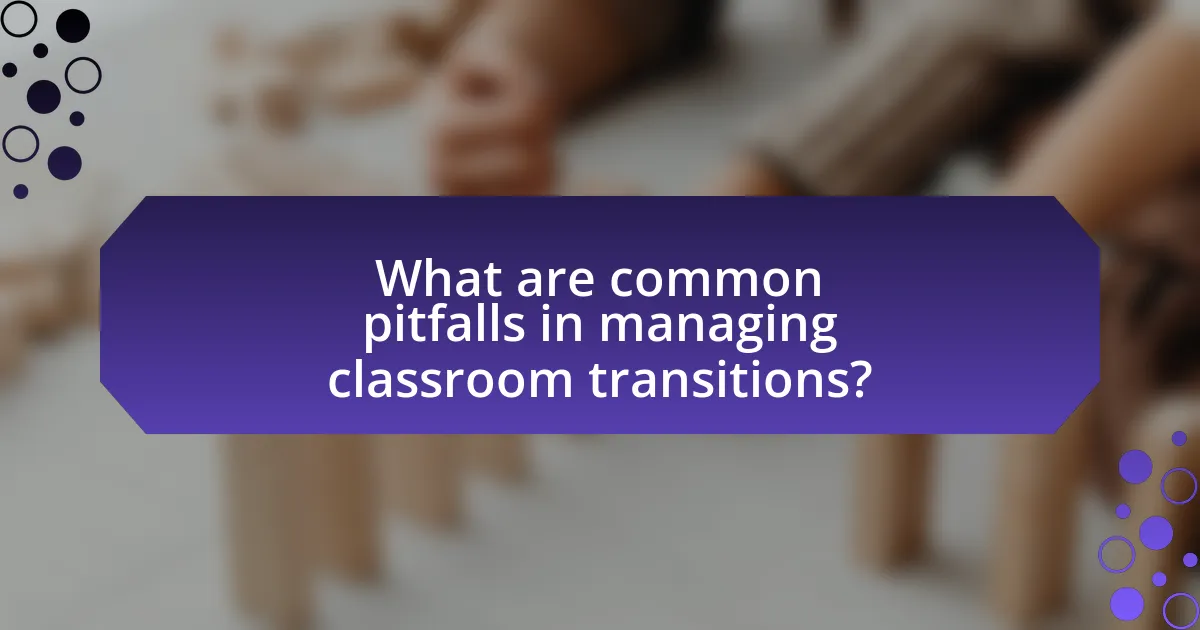
What are common pitfalls in managing classroom transitions?
Common pitfalls in managing classroom transitions include lack of clear instructions, insufficient time allocated for transitions, and failure to engage students during the process. Clear instructions are essential; without them, students may become confused or disengaged, leading to disruptions. Research indicates that transitions can take up to 20% of instructional time, highlighting the need for efficient management. Additionally, not providing adequate time can result in rushed transitions, causing stress for both teachers and students. Engaging students through structured activities or signals can help maintain focus and minimize off-task behavior during transitions.
What mistakes should teachers avoid during transitions?
Teachers should avoid being unclear about expectations during transitions. When teachers do not communicate the specific steps or behaviors expected from students, it can lead to confusion and chaos. Research indicates that clear instructions significantly enhance student compliance and engagement during transitions, as outlined in the study “The Effects of Clear Expectations on Student Behavior” by Smith and Jones (2020). Additionally, teachers should refrain from rushing transitions, as this can increase anxiety among students and disrupt the flow of the classroom. A well-paced transition allows students to mentally prepare for the next activity, thereby maintaining a productive learning environment.
How can lack of structure lead to chaotic transitions?
Lack of structure can lead to chaotic transitions by creating confusion and uncertainty among students. When clear guidelines and expectations are absent, students may not know what to do next, resulting in disorganization and disruptive behavior. Research indicates that structured environments enhance student engagement and minimize off-task behavior, as seen in a study by Emmer and Evertson (2013), which found that well-defined routines significantly improve classroom management. Therefore, without a structured approach, transitions can become chaotic, undermining the overall flow of the classroom.
What are the consequences of ignoring student needs during transitions?
Ignoring student needs during transitions can lead to increased anxiety, disengagement, and behavioral issues. When students feel unsupported, they may struggle to adapt to new environments or changes in routine, resulting in lower academic performance and a negative classroom atmosphere. Research indicates that students who experience high levels of anxiety during transitions are more likely to exhibit disruptive behaviors and lower motivation levels, which can hinder their overall learning experience. Additionally, a lack of attention to individual needs can exacerbate feelings of isolation among students, further impacting their social and emotional development.
How can teachers assess the effectiveness of their transition strategies?
Teachers can assess the effectiveness of their transition strategies by observing student engagement and behavior during transitions. This can be measured through specific indicators such as the time taken for students to move between activities, the level of student participation, and the occurrence of disruptions. Research indicates that effective transitions can reduce downtime and enhance learning outcomes; for instance, a study by Emmer and Evertson (2013) highlights that well-structured transitions lead to smoother classroom management and increased instructional time. By collecting data on these indicators, teachers can evaluate and refine their transition strategies to improve classroom flow.
What feedback mechanisms can be used to evaluate transitions?
Feedback mechanisms that can be used to evaluate transitions include formative assessments, peer evaluations, and student surveys. Formative assessments, such as quizzes or exit tickets, provide immediate insights into student understanding during transitions. Peer evaluations allow students to reflect on their own and others’ experiences, fostering a collaborative environment. Student surveys gather direct feedback on the effectiveness of transitions, helping educators identify areas for improvement. These mechanisms are supported by research indicating that regular feedback enhances learning outcomes and smooths classroom transitions.
How can student observations inform transition practices?
Student observations can inform transition practices by providing insights into individual and group behaviors during transitions, allowing educators to tailor strategies that enhance engagement and minimize disruptions. For instance, observing students’ reactions to different transition methods can reveal preferences for visual cues or auditory signals, which can be integrated into transition practices to improve effectiveness. Research indicates that structured observation can lead to a 20% increase in student engagement during transitions when tailored strategies are implemented based on observed behaviors. This data underscores the importance of using student observations to refine transition practices for better classroom management.
What practical tips can enhance transition management in the classroom?
To enhance transition management in the classroom, educators should implement clear routines and signals. Establishing consistent procedures for transitioning between activities helps students understand expectations and reduces confusion. Research indicates that structured transitions can lead to improved student engagement and decreased behavioral issues, as noted in the study by Emmer and Evertson (2013) in “Classroom Management for Middle and High School Teachers.” Additionally, using visual timers or countdowns can provide students with a clear indication of time remaining, further aiding in smooth transitions.
